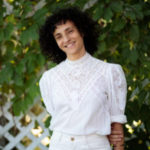 Rachel Bernsen is a nationally certified teacher of the Alexander Technique, M.AmSAT. She works with a range of students in private practice, supporting them in post-surgery recovery, injury rehabilitation, resolving sciatica, chronic neck and back pain, repetitive motion strain, managing scoliosis, and a range of issues related to movement impairment. She has worked with clients with MS, neuropathy, chronic pain, degenerative and structural spinal issues, among others.
Rachel Bernsen is a nationally certified teacher of the Alexander Technique, M.AmSAT. She works with a range of students in private practice, supporting them in post-surgery recovery, injury rehabilitation, resolving sciatica, chronic neck and back pain, repetitive motion strain, managing scoliosis, and a range of issues related to movement impairment. She has worked with clients with MS, neuropathy, chronic pain, degenerative and structural spinal issues, among others.
She also specializes in working with performing artists, individually and in groups, to help them gain greater facility and sensitivity and to deal with performance anxiety. She has served on the faculty and been a guest teacher at universities, conferences, movement studios, and festivals across the US and abroad. Rachel also teaches movement and improvisation.
Rachel recently relocated to White River Junction, VT from New Haven, CT where she had a studio and private practice for the last twelve years and taught locally at The Neighborhood Music School, Sarah Aldrich Pilates, The Educational Center for the Arts performing arts high school, and Yale University.
Rachel trained at the American Center for the Alexander Technique (ACAT) in NYC and received her teaching certification in 2008. She holds an MFA in Dance from NYU, Tisch School of the Arts. She is working toward an advanced AT certification in the Art of Breathing , to incorporate respiratory health and function more fully into her teaching. She is also training to become a Feldenkrais Awareness Through Movement (ATM) teacher, to be completed in 2023. Rachel is an an avid student of Iyengar Yoga and performs and makes work around the region and the globe. For more about her dance practice visit rachelbernsen.com
Why I became a teacher of the Alexander Technique:
I first encountered AT in 2002 as a dancer working professionally in NYC. I had no chronic injuries but suffered from regular bouts of acute low back and hip pain. I had just finished graduate school in dance. I was performing a lot, severely over-training and dealing with a multitude of low level strains. I also began struggling with muscle memory: having trouble remembering choreography. I was experiencing increased performance anxiety and as a result was losing a sense of ease, of pleasure in dancing. Knowing I needed change but without really knowing a remedy for these issues I began a journey toward a different approach to movement. I began taking dance classes with teachers who were influenced by the Alexander Technique-which at the time I didn’t know anything about. These dance artists/educators were integrating the principles of AT into their teaching and practice. Through this exposure I soon began taking workshops in Alexander Technique, then began private lessons. Over time, this shift in my training had a profoundly positive effect on my approach to movement – it became much more easeful – , my dynamic alignment, my technical ability and my over-all health. I no longer threw out my low back, my right hip stopped aching, I increased my range of motion, and I was much more present and available to the challenges and pleasures in dancing. Alexander also profoundly shifted my approach to my everyday activities.
(photo by Ben DeFlorio)
